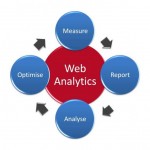
Ok, so you’ve got a website and on it you have all this information about your company — who your people are, what you do, how customers can contact/connect with you — and best of all: you get heaps of page views every month! Talk about winning the Internet! You’ve got this website marketing business down, am I right?
Except that maybe you don’t. And for this reason, we’re currently developing a new Digital Business Course to help businesses transition into the online world. A big part of that transition involves understanding how web analytics work, which is the bread and butter of any successful website — and indeed, successful business.
How to Use Web Analytics
To get the most out of web analytics, you kind of need to change the way you view your website. You need to see it as a form of marketing, just like an advertisement in a newspaper or a piece of direct mail. Once you start treating your website the same as you would any other marketing activity, it’s likely you’ll have some questions you’ll want answered.
Your Conversion Rate – Do YOU Know It?
Somewhere on this list — though we imagine that it would be on the top — should be “What’s my conversion rate?” To answer this question, you need web analytics. We recommend Google Analytics, namely because it’s free and extremely easy to use.
Your conversion rate is the number of people who have visited your website and carried out some form of action — signed up to a newsletter, made a request for more information, downloaded an e-book, and so on. In short, it’s any action that involves the exchange of information that you can later use to develop into a sale.
Constant Improvement
But the real genius of analytics lies in how it allows you to isolate problems with your website’s content and refine them. For instance, if you have a rather average conversion rate, but a high bounce rate (the number of people who leave your website within 30 seconds of landing on it), there’s a good chance that’s there’s something wrong with the keywords you’ve selected for your SEO. Or you’ve selected keywords that your website’s content doesn’t address properly. Either way, you need to fix this.
Finding Out How Your Customers Think
Once you do, you should see you bounce rate drop off and your conversion rate increase, which means more opportunity for more sales. And just think: if you didn’t have analytics, you’d have never known. This is what makes web analytics invaluable for small business owners, because it gives you rare insight into what makes your customers tick — what are they really looking for, and how can you adapt your business to meet their needs? — and provides you with the opportunity to meet those needs.
In essence, small business owners now have the same resources at their disposal as large multi-nationals, who typically spend bucket-loads on research and development, focus groups, and the like, trying to ascertain what exactly their customers are looking for — and even then, often don’t get it right.
***
At EzyLearn, we use web analytics extensively to ensure we’re constantly meeting the needs of our students and potential students. Through web analytics data, we ascertained that a number of small business owners were looking for a cheaper alternative to MYOB, so we developed two new cloud-accounting courses: the Reach Accounting Training Course and a Xero Training Course to satisfy that need.
For more information or to receive alerts about our forthcoming Digital Business Course, subscribe to our blog by clicking here.












